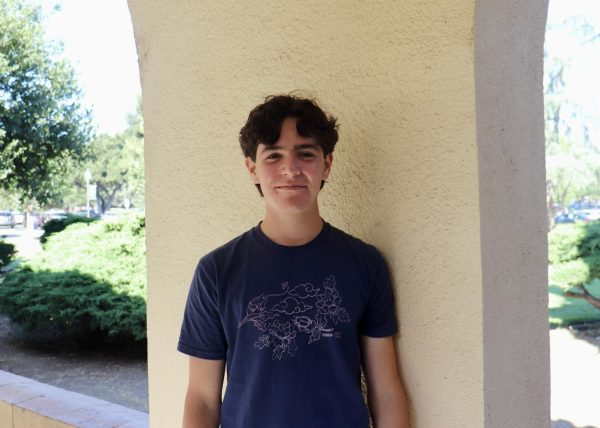Suburban Cinema
Ever wondered what your town would look like in a movie? Here is Palo Alto’s portrayal on the silver screen

Film, as a medium, has a magical ability to transport a viewer into the world it depicts. Among the myriad of factors that go into producing a film, the location of a film stands out as a crucial consideration for filmmakers. Palo Alto, having been featured in many movies over the course of cinematic history, is no exception to this rule.
Emilia Spitz, an arts and entertainment writer based in the Bay Area, discusses the necessity of establishing a background while hinting at underlying themes.
“When looking for a story set in a particular location, you’re either thinking about the attributes that make that location unique, or what social phenomenon is happening in that location,” Spitz said.
Specifically, Palo Alto, a symbol of technological innovation, is often depicted as the land of opportunity in films. “The Social Network” (2010) is a prime example of this type of portrayal. In the film, Palo Alto is referenced as the place to be if you want to be successful in the world of technology.
Edward Corpuz, the video production teacher at Paly, details the ways in which Palo Alto is represented positively.
“[Palo Alto] is the center of technology for the world,” Corpuz said. “It’s a place of innovation, of creativity and a lot of money, and you’ll see that in films.”
The opportunities and accomplishments associated with Palo Alto attract filmmakers across the globe. Additionally, the beautiful scenery of Palo Alto is a major factor in filming here. The picturesque town has brought directors of the TV show “Silicon Valley” (2014) downtown, to Local Union and to the Stanford Dish.
Dylan Duncan, Paly alum and a junior at Columbia College Chicago majoring in film, describes the charming environment of Palo Alto.
“There’s trees everywhere, there’s nice houses, there’s a bunch of parks, it’s very green and it’s a beautiful area,” Duncan said. “I think that that would draw a lot of people because it’s a small, quiet town.”
However, Palo Alto isn’t always shown in a positive light. When glamorized, it features abundant nature, paved sidewalks, beautiful buildings and bountiful business opportunities. But when criticized, it portrays a world based on competitive environments filled with out-of-touch and egotistical individuals.
Paly senior and Paly Film Club President, Bennett Hardy, resonates with the negative portrayal of Palo Alto in films.
“Palo Alto is depicted in movies as the rich, spoiled kids, in sports competitions [such as] in McFarland USA,” Hardy said. “They’re known as the egotistical, daddy’s-money-type people.”
“McFarland USA” (2015) isn’t the only movie that paints a cynical, yet not necessarily honest picture of Palo Alto. For example, “Take Your Pills” (2018) specifically mentions Palo Alto when referring to the impacts that harsh expectations and lots of competition can have on students. While the portrayal of Palo Alto in films may contribute to a toxic narrative, there is still some truth to the story.
“What people don’t realize is how much [of a] toll the expectations take on the students,” Duncan said. “We are going to Ivy League colleges [but] we also [have] one of the highest suicide rates in the country.”
Besides the negative portrayal of Palo Alto students in films, an aspect that is missed in movies is the diverse communities within greater Palo Alto that, in some ways, stray far from Palo Alto’s typical depiction. For instance, East Palo Alto, an incredibly diverse cultural melting pot, is rarely mentioned in movies.
“Less than five miles away from where we’re sitting here at Paly, across the freeway, into East Palo Alto, there are diverse communities,” Corpuz said, “There’s innovation there. There’s creativity, and there’s art. That’s the story that I’d want to tell.”
It is hard to know why East Palo Alto has been left out of films, but perhaps people believe it has been excluded because filmmakers don’t think it supports the story that they are trying to tell.
“We shouldn’t take the narrative that we see on screen as a truthful representation, even in documentaries, because there’s always a little bit of artistic touch and things that the directors need to do in order to show us the story,” Spitz said.
Of course, while creative liberties might always be taken in order to tell a better story, in the future it is possible that we will see portrayals of Palo Alto that more fully encapsulate the suburb.
“I hope to see one day that there’s a realistic representation of Palo Alto in film,” Hardy said. “There’s films coming out soon that might have a realistic representation [of Palo Alto], but you never know. It’s good to see yourself represented.”
Print Issue
Please click on the three vertical dots on the top right-hand corner, then select “Two page view.”

2022-2023 - Staff Writer
I've always loved flipping through the cool designs and stories in the C mag magazines after they are distributed on campus....

2022-2023 Staff Writer
2023-2024 Editor-In-Chief
I joined C-Mag because I'm really passionate about the arts, music, and just about anything C-Mag...

2020-2021 - Staff Writer
2021-2022 - Staff Writer
2022-2023 - Managing Editor
I joined C Mag because of the focus on arts and representing our...






